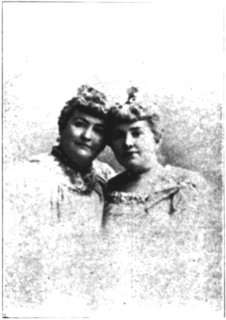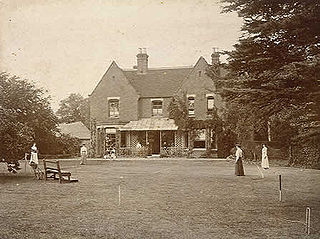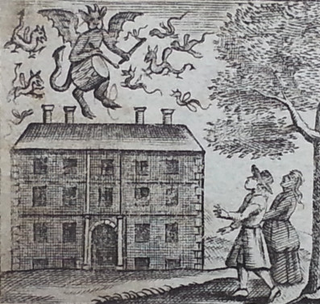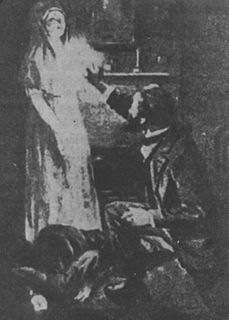 W
WThe Angels of Mons is a story of the reputed appearance of a supernatural entity which protected the British Army from defeat by the invading forces of the German Empire at the beginning of World War I during the Battle of Mons in Belgium on 23 August 1914.
 W
WIn parapsychology and spiritualism, an apport is the alleged paranormal transference of an article from one place to another, or an appearance of an article from an unknown source that is often associated with poltergeist activity or séances. Apports reported during séances have been found to be the result of deliberate fraud. No medium or psychic has demonstrated the manifestation of an apport under scientifically controlled conditions.
Jacques Aymar-Vernay was a stonemason from the village of Saint Marcellin in Dauphiné, France, who reintroduced dowsing with a divining rod into popular usage in Europe. He claimed to have discovered springs and treasures hiding in the earth using his rod, and even tracked down criminals using it. According to some accounts, when he neared the scene of a murder using a divining rod, he would break into a sweat, shudder and, in some instances, even faint.
 W
WBallechin House was a Georgian estate home near Grandtully, Perthshire, Scotland. It was built in 1806, on the site of an old manor house which had been owned by the Steuart family since the 15th century.
 W
WThe Bangs Sisters, Mary "May" E. Bangs (1862-1917) and Elizabeth "Lizzie" Snow Bangs (1859-1920), were two fraudulent spiritualist mediums from Chicago, who made a career out of painting the dead or "Spirit Portraits".
 W
WThe Bélmez Faces or the Faces of Bélmez is an alleged paranormal phenomenon in a private house in Spain. The phenomenon started in 1971 when residents claimed images of faces appeared in the concrete floor of the house.
 W
WThe Blair Witch Project is a 1999 American supernatural horror film written, directed and edited by Daniel Myrick and Eduardo Sánchez. It is a fictional story of three student filmmakers—Heather Donahue, Michael C. Williams, and Joshua Leonard—who hike into the Black Hills near Burkittsville, Maryland in 1994 to film a documentary about a local legend known as the Blair Witch. The three disappear, but their equipment and footage are discovered a year later. The purportedly "recovered footage" is the film the viewer sees. Myrick and Sánchez conceived of a fictional legend of the Blair Witch in 1993. They developed a 35-page screenplay with the dialogue to be improvised. A casting call advertisement in Backstage magazine was prepared by the directors; Donahue, Williams and Leonard were cast. The film entered production in October 1997, with the principal photography taking place in Maryland for eight days. About 20 hours of footage was shot, which was edited down to 82 minutes. Shot on an original budget of $35,000–60,000, the film had a final cost of $200,000–750,000 after post-production edits.
 W
WBorley Rectory was a house that gained infamy as "the most haunted house in England" after being described as such by psychic researcher Harry Price. Built in 1862 to house the rector of the parish of Borley and his family, it was badly damaged by fire in 1939 and demolished in 1944.
 W
WCaledonia Mills is a community in the Canadian province of Nova Scotia, located in Antigonish County.
 W
WThe Cock Lane ghost was a purported haunting that attracted mass public attention in 1762. The location was a lodging in Cock Lane, a short road adjacent to London's Smithfield market and a few minutes' walk from St Paul's Cathedral. The event centred on three people: William Kent, a usurer from Norfolk, Richard Parsons, a parish clerk, and Parsons' daughter Elizabeth.
 W
WThe Cottingley Fairies appear in a series of five photographs taken by Elsie Wright (1901–1988) and Frances Griffiths (1907–1986), two young cousins who lived in Cottingley, near Bradford in England. In 1917, when the first two photographs were taken, Elsie was 16 years old and Frances was 9. The pictures came to the attention of writer Sir Arthur Conan Doyle, who used them to illustrate an article on fairies he had been commissioned to write for the Christmas 1920 edition of The Strand Magazine. Doyle, as a spiritualist, was enthusiastic about the photographs, and interpreted them as clear and visible evidence of psychic phenomena. Public reaction was mixed; some accepted the images as genuine, others believed that they had been faked.
 W
WMina "Margery" Crandon was a psychical medium who claimed that she channeled her dead brother, Walter Stinson. Investigators who studied Crandon concluded that she had no genuine paranormal ability, and others detected her in outright deception. She became known as her alleged paranormal skills were touted by Sherlock Holmes author Sir Arthur Conan Doyle and were disproved by magician Harry Houdini. Crandon was investigated by members of the American Society for Psychical Research and employees of the Scientific American.
 W
WThe Drummer of Tedworth is a case of an alleged poltergeist manifestation in the West Country of England by Joseph Glanvill, from his book Saducismus Triumphatus (1681).
 W
WVictoria Helen McCrae Duncan was a fraudulent Scottish medium best known as the last person to be imprisoned under the Witchcraft Act of 1735 for fraudulent claims. She was famous for producing ectoplasm which was proven to be made from cheesecloth.
 W
WEctoplasm is a term used in spiritualism to denote a substance or spiritual energy "exteriorized" by physical mediums. It was coined in 1894 by psychical researcher Charles Richet. Although the term is widespread in popular culture, the physical existence of ectoplasm is not accepted by science and many purported examples were exposed as hoaxes fashioned from cheesecloth, gauze or other natural substances.
 W
WA séance or seance is an attempt to communicate with spirits. The word séance comes from the French word for "session", from the Old French seoir, "to sit". In French, the word's meaning is quite general: one may, for example, speak of "une séance de cinéma". In English, however, the word came to be used specifically for a meeting of people who are gathered to receive messages from ghosts or to listen to a spirit medium discourse with or relay messages from spirits. In modern English usage, participants need not be seated while engaged in a séance.
 W
WDie Glocke was a purported top-secret Nazi scientific technological device, secret weapon, or Wunderwaffe. First described by Polish journalist and author Igor Witkowski in Prawda o Wunderwaffe (2000), it was later popularized by military journalist and author Nick Cook who associated it with Nazi occultism, antigravity and free energy research. Mainstream reviewers have criticized claims about Die Glocke as being pseudoscientific, recycled rumors, and a hoax. Die Glocke and other alleged Nazi "miracle weapons" have been dramatized in video games, television shows, and novels.
 W
WHuman magnetism is a popular name for an alleged ability of some people to attract objects to their skin. People alleged to have such an ability are often called human magnets. Although metal objects are the most popular, some are also alleged to be able to stick other types of materials, such as glass, porcelain, wood or plastic as well as metals with no ferromagnetic properties such as brass and aluminium. However, none of the recorded claims of human magnetism corresponds with the physics of magnetism, indicating that this "ability" is in fact nothing more than a misunderstanding of the physics and meaning of the term and a misapplication of it to what has been shown to be nothing more than unusually sticky skin.
 W
WIn Southern New Jersey and Philadelphia folklore, the Jersey Devil is a legendary creature said to inhabit the Pine Barrens of South Jersey. The creature is often described as a flying biped with hooves, but there are many variations. The common description is that of a bipedal kangaroo-like or wyvern-like creature with a horse- or goat-like head, leathery bat-like wings, horns, small arms with clawed hands, legs with cloven hooves, and a forked tail. It has been reported to move quickly and is often described as emitting a high-pitched "blood-curdling scream".
 W
WKoot Hoomi is said to be one of the Mahatmas that inspired the founding of the Theosophical Society in 1875. He engaged in a correspondence with two English Theosophists living in India, A. P. Sinnett and A. O. Hume, which correspondence was published in the book The Mahatma Letters to A. P. Sinnett.
 W
WLucy Lightfoot is the name of a fictional girl who supposedly disappeared mysteriously from the Isle of Wight in 1831. The story was fabricated by James Evans, the vicar of St Olave's Church, Gatcombe, in the early 1960s, as he himself later admitted.
 W
WIn spiritualism, paranormal literature and some religions, materialization is the creation or appearance of matter from unknown sources. The existence of materialization has not been confirmed by laboratory experiments. Numerous cases of fraudulent materialization demonstrations by mediums have been exposed.
 W
WMinsden Chapel is an isolated ruined chapel in the fields above the hamlet of Chapelfoot, near Preston, Hertfordshire. Today it is a roofless shell, partly surrounded by a small wood, and accessible only by footpath. It is a Scheduled Ancient Monument and is Grade II Listed.
 W
WEdward Moor (1771–1848) was a British soldier and Indologist, known for his book The Hindu Pantheon, an early treatment in English of Hinduism as a religion.
 W
WWilliam H. Mumler (1832–1884) was an American spirit photographer who worked in New York and Boston. His first spirit photograph was apparently an accident—a self-portrait which, when developed, also revealed the "spirit" of his deceased cousin. Mumler then left his job as an engraver to pursue spirit photography full-time, taking advantage of the large number of people who had lost relatives in the American Civil War. His two most famous images are the photograph of Mary Todd Lincoln with the ghost of her husband Abraham Lincoln and the portrait of Master Herrod, a medium, with three spirit guides.
 W
WThe Pangboche Hand is an artifact from a Buddhist monastery in Pangboche, Nepal. Supporters contend that the hand is from a Yeti, a scientifically unrecognized animal purported to live in the Himalayan mountains. A finger bone from the hand was tested and the DNA shown to be human.
 W
WParanormal Witness is an American paranormal documentary television series made by a British production company which described itself as "true tales of supernatural hauntings and explanation-defying paranormal experiences, which are brought to life through recreations". The series premiered on September 7, 2011, on Syfy. It is also shown in the UK on Really, W, and Pick, in the United Kingdom.
 W
WPyrokinesis is the purported psychic ability allowing a person to create and control fire with the mind. As with other parapsychological phenomena, there is no conclusive evidence in support of the actual existence of pyrokinesis. Many alleged cases are hoaxes, the result of trickery.
 W
WLobsang Rampa is the pen name of an author who wrote books with paranormal and occult themes. His best known work is The Third Eye, published in Britain in 1956.
 W
WThe Rosenheim Poltergeist is the name given to claims of a poltergeist in Rosenheim in southern Bavaria in the late 1960s by German parapsychologist Hans Bender. Bender alleged that electrical and physical disturbances in the office of the lawyer Sigmund Adam were caused by the telekinetic powers of 19-year-old secretary Annemarie Schaberl. Bender's investigation has been criticized for omitting key details and avoiding naturalistic explanations.
 W
WSampford Peverell is a village and civil parish in Mid-Devon, England. An old Saxon settlement, it was called Sanforda in the 1086 Doomsday Book. Its current name reflects its inclusion in the Honour of Peverel, the lands of William Peverel and his family. His great-grandson, Hugh Peverell, is buried in the village church of St John the Baptist. The parish is surrounded, clockwise from the north, by the parishes of Hockworthy, Holcombe Rogus, Burlescombe, Halberton and Uplowman.
 W
WAlbert Freiherr von Schrenck-Notzing was a German physician, psychiatrist and notable psychical researcher, who devoted his time to the study of paranormal events connected with mediumship, hypnotism and telepathy. He investigated Spiritualist mediums such as Willi Schneider, Rudi Schneider, and Valentine Dencausse. He is credited as the first forensic psychologist by Guinness World Records.
 W
WTheodore "Ted" Judd Serios was a Chicago bellhop known for his production of "thoughtographs" on Polaroid film. He claimed these were produced using psychic powers. Serios' psychic claims were bolstered by the endorsement of a Denver-based psychiatrist, Jule Eisenbud (1908–1999), who published a book named The World of Ted Serios: "Thoughtographic" Studies of an Extraordinary Mind (1967) arguing that Serios' purported psychic abilities were genuine. However, professional photographers and skeptics have argued that Serios and his photographs were fraudulent.
 W
WSpirit photography is a type of photography whose primary goal is to capture images of ghosts and other spiritual entities, especially in ghost hunting. It dates back to the late 19th century. The end of the American Civil War and the mid-19th Century Spiritualism movement contributed greatly to the popularity of spirit photography. Photographers such as William Mumler and William Hope ran thriving businesses taking photos of people with their supposed dead relatives. Both were shown to be frauds, but "true believers", such as Sir Arthur Conan Doyle, refused to accept the evidence as proof of a hoax.
 W
WThe Third Eye is a book published by Secker & Warburg in November 1956. It was originally claimed that the book was written by a Tibetan monk named Lobsang Rampa. On investigation the author was found to be one Cyril Henry Hoskin (1910–1981), the son of a British plumber, who claimed that his body was occupied by the spirit of a Tibetan monk named Tuesday Lobsang Rampa. The book is considered a hoax.
 W
WThoughtography, also called projected thermography, psychic photography, nengraphy, and nensha (Japanese: 念写), is the claimed ability to "burn" images from one's mind onto surfaces such as photographic film by psychic means. While the term "thoughtography" has been in the English lexicon since 1913, the more recent term "projected thermography" is a neologism popularized in the 2002 U.S. film The Ring, a remake of the 1998 Japanese horror film Ring.